How much do you know about Lambrusco wines? If you say, “not much,” you are not alone. Produced exclusively in Italy’s Emilia-Romagna region between Modena and Bologna, Lambrusco for decades had a reputation as a sweetish sparkling red wine, easy to drink and not much to think about.
A recent discovery trip to Modena and the surrounding production zones revealed that Lambrusco is much more than this. Light, fizzy, fresh and low in alcohol – usually below 12% ABV – Lambruscos are made in a spectrum of colors and styles and sweetness levels. You will see them in hues of pale pink to salmon rosé (rosato in Italian) to deep garnet and almost blackberry red (rosso). Styles range from crisp dry and floral to fruity and juicy to semi-sweet – called amabile – the one you probably thought of as traditional Lambrusco.
A commonality with all Lambrusco wines is they deliver a refreshing effervescence, from frizzante (lightly bubbly) to spumante full-on sparkling. The majority are made in the Charmat method although you can find Lambruscos made in the traditional method (metodo classico) and ancestral method (akin to pet-nats). A characteristic of Lambrusco is the soft foamy mousse that develops when it is poured into a wine glass, similar to the head of a beer. Lambrusco wines are light, refreshing and easy to drink They are best consumed within two years of bottling.
Lambrusco refers to the style of wine and the grapes used to make it, and may also be the name of the production area. Lambrusco can be produced from twelve grape varieties. The most prominent are Lambrusco di Sorbara, Lambrusco di Grasparossa and Lambrusco di Salamino.
There are three main styles of Lambrusco and some variations in between based on the production zone. Here is what distinguishes each:
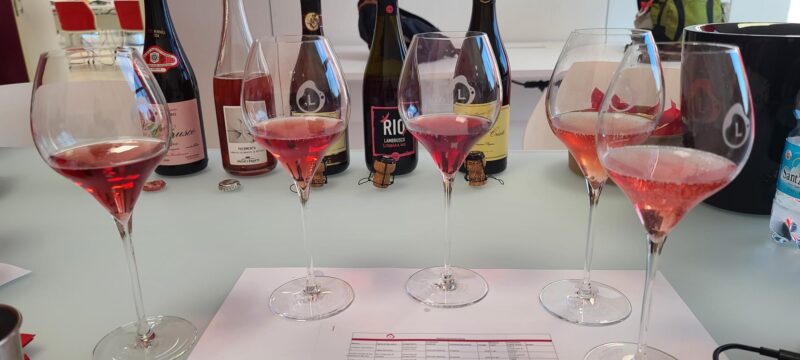
A tasting flight of Lambrusco di Sorbara
Lambrusco di Sorbara: Most often in the rosé range, Lambrusco di Sorbara is a drier style wine with higher acidity. The color is paler, ranging from light pink to rosy to light garnet. The aromas and flavors deliver more red berries (strawberry, raspberry), red cherry and violet notes. The finish is clean and crisp.
Lambrusco di Grasparossa: This wine is a red Lambrusco with colors ranging from dark plum to blackberry. The aromas and flavors are ripe dark berries, black cherry and plum with a bright, refreshing finish,
Lambrusco Amabile is a semi-sweet style of red Lambrusco, usually darker and with higher residual sugar.
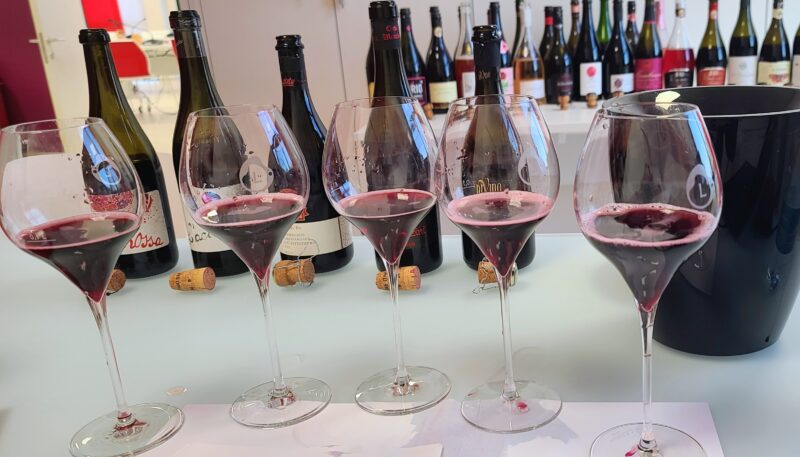
A tasting flight of Lambrusco di Grasparossa
Lambrusco is also versatile with food pairings from savory, salty, fatty and spicy as to fresh fruits, tangy cheeses and light desserts. In Emilia- Romagna, Lambrusco is a natural pairing with the region’s renowned Parmigiano-Reggiano, prosciutto di Parma, and dishes made with the traditional balsamic vinegar from Modena. Basically, there is a Lambrusco for everyone and for every course.
On a recent visit arranged by the Consorzio Tutela Lambrusco we tasted six flights of different styles Lambrusco to acquaint our palates and visited six producers in three DOC production zones near the town of Modena where we were based. Lucky for us, because Modena is beautiful and walkable, and the area produces the renowned balsamic vinegar di Modena which we enjoyed on pasta dishes and drizzled over chunks of Parmigiano-Reggiano, another specialty of Emilia-Romagna, along with Mortadella and prosciutto di Parma. The local cuisine was buttery, rich and plentiful. Lambrusco wines with their high acidity can stand up to these fat, salt and savory textures and flavors.
We visited six producers. Coincidentally, three of them are celebrating their centennials.
Azienda Vinicola Alfredo Bertolani US Importer: Regal Wines (New York). Founded in 1925 by Alfredo Bertolani, this is one of the centennial wineries in Reggio Emilio. It is overseen by the fourth generation of the Bertolani family, which includes Andrea Bertolani who led our tour and tasting. Reggio Emilia is considered the heart of Lambrusco production amid the hills of Scandiano between Modena and Parma. Compared to the more humid plains where we drove through thick morning fog, this area is protected by the hills with a natural cooling system. Soils are a combination of clay, chalk and sand. The Lambrusco wines produced here tend to be fuller bodied with more sapidity. Spergola, local white grape variety, is a big focus at Bertolani. The frizzante wines made with 100 percent Spergola tended to deliver more savory notes with herbal and almond hints and very high acidity.
Cantina Puianello e Coviolo US Importer: Skurnik Wines
Founded in 1938 by five visionary individuals, Cantine Puianello is now a cooperative of 180 members in Reggio Emilia, considered the heart of the Lambrusco region. The focus is quality over quantity. Grapes must be sourced from the partner vineyards which extend 200 hectares in the surrounding hills from Scandiano to Canossa. The cantina has stunning murals by artist Simone Ferrarini that depict historical figures and winery workers.
Cantina Paltrinieri U.S. Importer: Polaner
In 1926, Achille Paltrineri established his namesake winery. Since 1998, the estate has been run by the fourth generation Alberto Paltrinieri and his wife, Barbara, and their offspring. Paltrinieri is in the heart of Sorbara DOC. Production is mainly Charmat and metodo classico. Paltrinieri also produces balsamic vinegar and has a small facility on site for production.
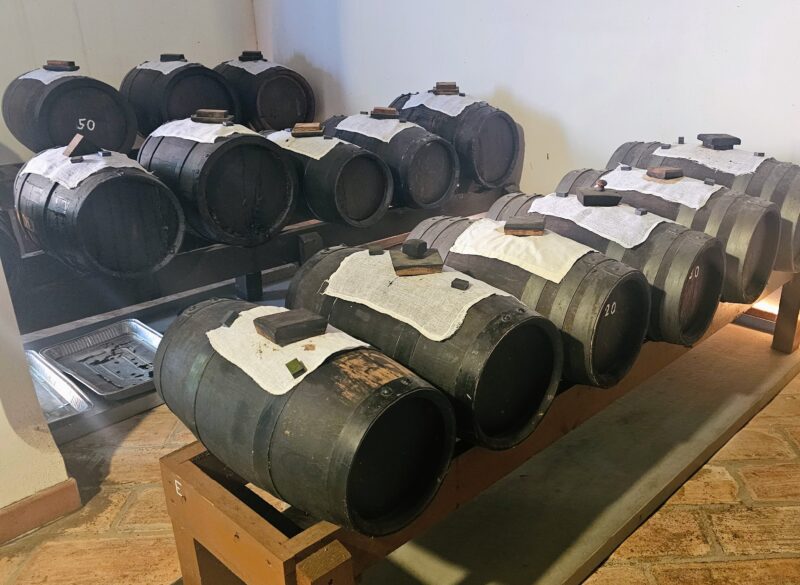
In addition to its Lambrusco wines, Paltrinieri produces balsamic vinegar, a specialty of Modena. Photo in the barrel room.
Cantina Francesco Bellei U.S. Importer: none at this time.
Founded in the 1920s, Bellei is now the property of Cavicchioli family who also produce wine in Franciacorta. They chose to honor the founder by retaining the Bellei name for the cantina. Metodo classico production wines are the main focus. However, we also tried some method ancestral wines including an Ancestral Pignoletto 2022 made from variety native to the Bologna area. Named for its tight, pine-shaped clusters, Pignoletto is also known as Grechetto Gentile. The grape has bitter, nutty characteristics, resulting in a high-acid dry sparkling wine.
Tenuta Galvana Superiore U.S. Importer: Fratelli del Vino
Located amid the hills of Castelvetro di Modena, this family run wine estate was founded in 1974 by Marini Leonelli and Donini Bruna. Their son, Paolo Lionelli, is in charge now. Wines are certified organic, and everything is hand-harvested.
Lombardini U.S. Importer: Vignaioli Imports
Founded in 1925 by Angelo Lombardini, family-run Lombardini is now overseen by winemaker, Marco Lombardini, and his three daughters, Chiara, Cecilia and Virginia. The winery is in the town of Novellara and is housed in a former movie theater. Lombardini produces a range of sparkling wines, including their flagship Campanone Frizzante 2024 which was named the #1 sparkling wine at the recent World Sparkling Championships. (not available in the USA).
If you go, base yourself in Modena and enjoy this historic, walkable city. We stayed at the Hotel Phi Canalgrande. It is advisable to hire a car and driver and, if language is a barrier, an Italian speaking guide. Advance reservations are necessary to visit wineries.
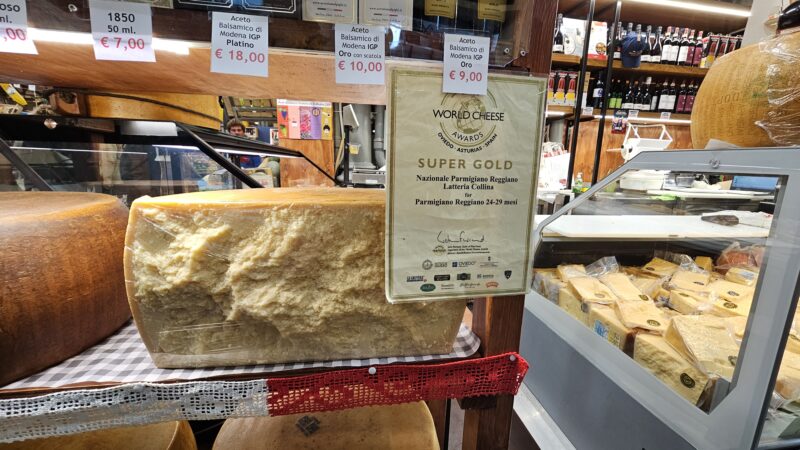
Wheel of local Parmigiano Reggiano cheese at the Mercato Storico Albinelli in Modena
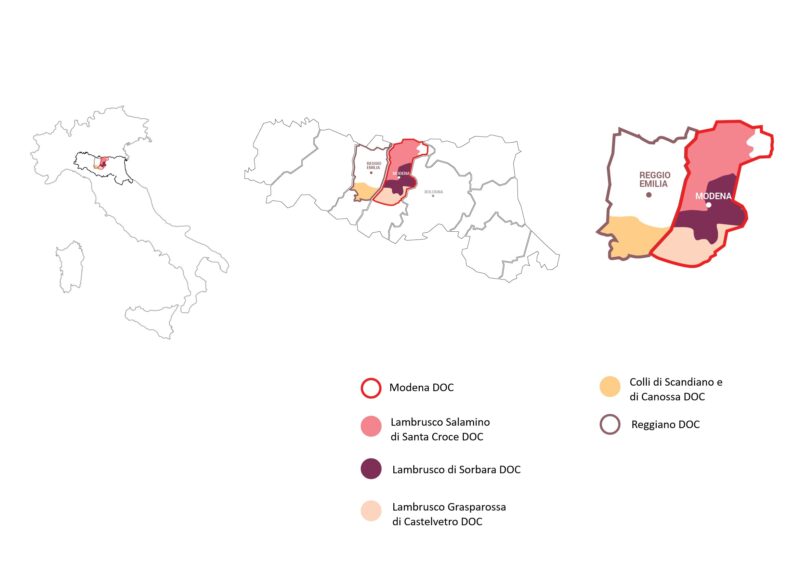
Map of the main Lambrusco production regions provided by the Consorzio Tutela Lambrusco
Watch our recap from our visit to Modena and meeting the Lambrusco producers on The Connected Table Live @ YouTube: Italy’s Lambrusco: One Wine, Many Styles – Vivacious and Versatile
We thank the Consorzio Tutela Lambrusco for organizing our trip. Here is a link to a selection of tours to consider. Modena Tours & Activities – 89 Suggested Activities | Luxury Experiences Travel
